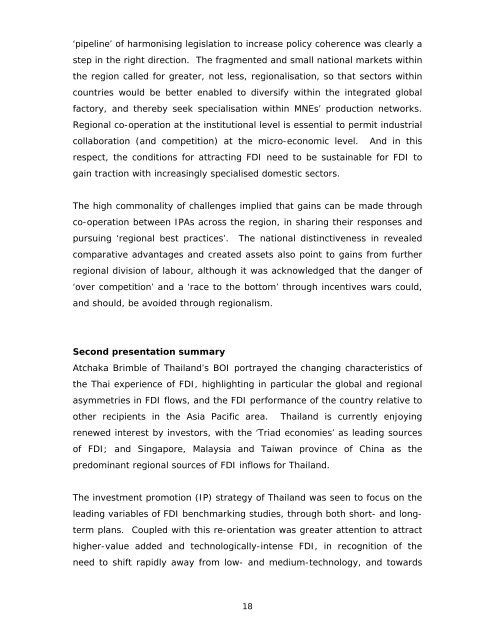(EGM) Foreign Direct Investment in Southeast Asia - Unido
(EGM) Foreign Direct Investment in Southeast Asia - Unido
(EGM) Foreign Direct Investment in Southeast Asia - Unido
Create successful ePaper yourself
Turn your PDF publications into a flip-book with our unique Google optimized e-Paper software.
‘pipel<strong>in</strong>e’ of harmonis<strong>in</strong>g legislation to <strong>in</strong>crease policy coherence was clearly a<br />
step <strong>in</strong> the right direction. The fragmented and small national markets with<strong>in</strong><br />
the region called for greater, not less, regionalisation, so that sectors with<strong>in</strong><br />
countries would be better enabled to diversify with<strong>in</strong> the <strong>in</strong>tegrated global<br />
factory, and thereby seek specialisation with<strong>in</strong> MNEs’ production networks.<br />
Regional co-operation at the <strong>in</strong>stitutional level is essential to permit <strong>in</strong>dustrial<br />
collaboration (and competition) at the micro-economic level. And <strong>in</strong> this<br />
respect, the conditions for attract<strong>in</strong>g FDI need to be susta<strong>in</strong>able for FDI to<br />
ga<strong>in</strong> traction with <strong>in</strong>creas<strong>in</strong>gly specialised domestic sectors.<br />
The high commonality of challenges implied that ga<strong>in</strong>s can be made through<br />
co-operation between IPAs across the region, <strong>in</strong> shar<strong>in</strong>g their responses and<br />
pursu<strong>in</strong>g ‘regional best practices’. The national dist<strong>in</strong>ctiveness <strong>in</strong> revealed<br />
comparative advantages and created assets also po<strong>in</strong>t to ga<strong>in</strong>s from further<br />
regional division of labour, although it was acknowledged that the danger of<br />
‘over competition’ and a ‘race to the bottom’ through <strong>in</strong>centives wars could,<br />
and should, be avoided through regionalism.<br />
Second presentation summary<br />
Atchaka Brimble of Thailand’s BOI portrayed the chang<strong>in</strong>g characteristics of<br />
the Thai experience of FDI, highlight<strong>in</strong>g <strong>in</strong> particular the global and regional<br />
asymmetries <strong>in</strong> FDI flows, and the FDI performance of the country relative to<br />
other recipients <strong>in</strong> the <strong>Asia</strong> Pacific area. Thailand is currently enjoy<strong>in</strong>g<br />
renewed <strong>in</strong>terest by <strong>in</strong>vestors, with the ‘Triad economies’ as lead<strong>in</strong>g sources<br />
of FDI; and S<strong>in</strong>gapore, Malaysia and Taiwan prov<strong>in</strong>ce of Ch<strong>in</strong>a as the<br />
predom<strong>in</strong>ant regional sources of FDI <strong>in</strong>flows for Thailand.<br />
The <strong>in</strong>vestment promotion (IP) strategy of Thailand was seen to focus on the<br />
lead<strong>in</strong>g variables of FDI benchmark<strong>in</strong>g studies, through both short- and long-<br />
term plans. Coupled with this re-orientation was greater attention to attract<br />
higher-value added and technologically-<strong>in</strong>tense FDI, <strong>in</strong> recognition of the<br />
need to shift rapidly away from low- and medium-technology, and towards<br />
18

















